Overview of Quebec

Photo credit: abdallahh
The province has a wide variety of landscapes, climatic regions and vegetation, and therefore a vast variety of tourist attractions, scenic routes and holiday getaways to offer travellers. The wilderness prevails in the most northerly reaches, with thick forests and clear lakes dominating the landscape.
This in turn gives way to the snowy mountains of the Laurentians, which is popular resort country, while down south lies the urban sprawl of Canada's French-speaking cities and the rolling pastures of the farmlands. Quebec has 22 national parks and a variety of stunningly beautiful natural landmarks, including Montmorency Falls outside of Quebec City and the Gaspé Peninsula on the St Lawrence River.
Quebec has a uniquely French flavour, remaining the only North American region to preserve its Francophone identity. In Quebec, French is the official language and is spoken by more than 80 percent of the population.
For decades the province has been dogged by political battles regarding secession, but moves to turn Quebec into a sovereign state have been put on the back burner in favour of concentrating on economic development.
Key Facts
- Language:
- The official languages are English and French (spoken predominantly in Quebec).
- Passport/Visa:
All visitors must hold a valid passport, and it's recommended that passports always be valid for six months after the intended period of travel. Visitors are required to hold onward or return tickets, all documents needed for the next destination and sufficient funds to cover the period of intended stay.
Travellers from most visa-exempt countries arriving in Canada by air need to fill in an Electronic Travel Authorisation (eTA) form online prior to visiting Canada. This requirement is applicable to all but U.S citizens and travellers with a valid Canadian visa. Canadian citizens, including dual citizens, and Canadian permanent residents cannot apply for an eTA. As part of the Western Hemisphere Travel Initiative (WHTI), all travellers travelling between the United States and Canada, Mexico, Bermuda, and the Caribbean region are required to present a passport or other valid travel documents to enter or re-enter the United States. If departing from the USA a valid passport will be required by immigration authorities.
- Currency:
The currency used is the Canadian dollar (CAD). Banks and bureaux de change will change cash, as will some hotels. Major credit cards are widely accepted and ATMs are widespread. US dollars are widely accepted.
- Electricity:
- Electrical current is 120 volts, 60Hz. American-style flat two-pin plugs and a plug with a third round grounding pin are standard.
Travel Advisories
Travel to Quebec
Climate
Covering such a huge area, the climate of Quebec has wide temperature variations. In the south, where most of the population lives, the weather is continental, with four seasons varying from hot summers (June to August) to cold, snowy winters and lots of rain.
The central region has longer, colder winters and shorter, cooler summers, while the far north experiences a severe Arctic climate with a freezing winter and permafrost. Winter can vary from five months in the south to eight months in the north, averaging between 14ºF (-10ºC) and -13ºF (-25ºC).
Health Notes when travelling to Canada
Travellers should be up to date with your COVID-19 vaccines before traveling to Canada, and should consider taking routine vaccines as a standard precaution. Medical care is excellent but expensive, so medical insurance is advised.
Safety Notes when travelling to Canada
While most visits to Canada are trouble-free, the country does share the common international risk of terrorism. The crime rate is low but travellers are advised to take sensible precautions to safeguard their belongings, as they would anywhere. Parts of Canada are prone to tornadoes between May and September.
Customs in Canada
Rowdiness and loud speech are inappropriate except under special circumstances or in places such as bars, as Canadians tend to be soft spoken, patient and almost apologetic in their public behaviour. They are generally tolerant of the complex network of cultural differences in public behaviour, particularly in cities where such diversity is more common place. Recreational cannabis is legally available throughout Canada, though local laws can vary depending on the province or territory travellers are visiting.
Duty Free in Canada
Travellers to Canada are allowed to enter the country with the following items without incurring custom duties: gifts to the value of C$60 per recipient (excluding advertising material, tobacco and alcoholic beverages); 200 cigarettes, 50 cigars or cigarillos and 200g of tobacco or 200 tobacco sticks; 1.14 litres of liquor or wine or 24 x 355ml bottles or cans of beer or ale. There are strict regulations governing the import of the following: explosives, endangered animal and plant species, items of heritage, fresh foodstuffs and weapons.
Doing Business in Canada
Vancouver, Toronto, Calgary, and Montreal are the main business centres, and English is the language of business except in French-speaking Quebec, where all written material and business cards should be in French. Business cards are not traditionally exchanged during an initial meeting, but at some appropriate time thereafter; it is best to wait for the host to offer theirs first.
A firm handshake is used by way of greeting and punctuality should be taken seriously for meetings. Canadians dress conservatively and smartly for business and suits are the norm. Gifts can be given in conclusion to celebrate a deal, but should be understated; taking someone out for a meal is a popular way to conclude business dealings.
Canadians are reserved and frown on emotional outbursts. Business is based on facts and figures rather than relationships, so it is best to be as prepared as possible for meetings. Hours of business are usually 9am to 5pm, Monday to Friday.
Communication in Canada
The international access code for Canada is +1. The outgoing code is 011 followed by the relevant country code. The outgoing code is not necessary for calls to the US and the Caribbean. Hotels, cafes and restaurants offering free WiFi are widely available. As international roaming costs can be high, purchasing a local prepaid SIM card can be a cheaper option.
Tipping in Canada
A tip of around 15 percent is standard in restaurants, and hairdressers and taxi drivers are usually tipped at the same rate. Bellhops, doormen, porters, and similar service providers at hotels, airports, and stations are generally paid at the customer's discretion.
Passport/Visa Note
All visitors must hold a valid passport, and it's recommended that passports always be valid for six months after the intended period of travel. Visitors are required to hold onward or return tickets, all documents needed for the next destination and sufficient funds to cover the period of intended stay.
Travellers from most visa-exempt countries arriving in Canada by air need to fill in an Electronic Travel Authorisation (eTA) form online prior to visiting Canada. This requirement is applicable to all but U.S citizens and travellers with a valid Canadian visa. Canadian citizens, including dual citizens, and Canadian permanent residents cannot apply for an eTA. As part of the Western Hemisphere Travel Initiative (WHTI), all travellers travelling between the United States and Canada, Mexico, Bermuda, and the Caribbean region are required to present a passport or other valid travel documents to enter or re-enter the United States. If departing from the USA a valid passport will be required by immigration authorities.
Entry Requirements
- Entry requirements for Americans:
US travellers should have a valid passport if departing from the USA. Other proof of citizenship is accepted in the form of a birth certificate, a US certificate of citizenship, a US certificate of naturalisation, or a NEXUS card. A visa is not required for a stay of up to six months.
- Entry requirements for UK nationals:
UK nationals must have a passport valid for the period of intended stay. A visa is not required for a stay of up to six months, though UK travellers must have Electronic Travel Authorisation (eTA).
- Entry requirements for Australians:
Australians must hold passports valid for period of intended stay. Nationals of Australia with an Electronic Travel Authorisation (eTA) are visa exempt for a maximum stay of 6 months.
- Entry requirements for Irish nationals:
Irish nationals must hold a passport valid for the period of intended stay. A visa is not required for stays of up to six months. However, the individual must have an Electronic Travel Authorisation (eTA).
- Entry requirements for New Zealanders:
New Zealanders require a passport valid for the period of the intended stay. No visa is required for stays of up to 6 months. However, the traveller requires an Electronic Travel Authorisation (eTA).
- Entry requirements for South Africans:
South African nationals must be in possession of a passport valid for the period of intended stay. A visa is required. South African temporary passports are not recognised. Passports, identity or travel documents of Bophuthatswana, Ciskei, Transkei and Venda are not accepted.
Currency
The currency used is the Canadian dollar (CAD). Banks and bureaux de change will change cash, as will some hotels. Major credit cards are widely accepted and ATMs are widespread. US dollars are widely accepted.
| Exchange rate for 1 CAD - Canadian Dollar | |||||
|---|---|---|---|---|---|
|
0.00 BMD Bermudan Dollar |
0.68 EUR Euro |
0.73 USD U.S. Dollar |
0.58 GBP U.K. Pound Sterling |
111.95 JPY Japanese Yen |
0.66 CHF Swiss Franc |
|
1.11 AUD Australian Dollar |
28.83 UAH Ukrainian Hryvnia |
324.82 KZT Kazakhstani Tenge |
68,104.49 LBP Lebanese Pound |
3.55 LYD Libyan Dinar |
5.02 BOB Bolivian Boliviano |
|
0.00 NPR Nepalese Rupee |
0.00 OMR Omani Rial |
0.00 QAR Qatari Rial |
0.99 SGD Singapore Dollar |
7.92 SEK Swedish Krona |
0.00 TTD Trinidad Tobago Dollar |
|
0.00 VEF Venezuelan Bolivar |
42.52 DOP Dominican Peso |
0.00 HRK Croatian Kuna |
12.41 MXN Mexican Peso |
446.74 XOF West African CFA Franc |
0.00 PGK Papua New Guinean kina |
|
0.00 BSD Bahamian Dollar |
0.00 FJD Fiji Dollar |
0.00 HNL Honduran Lempira |
97.95 DZD Algerian Dinar |
0.00 MMK Myanma Kyat |
0.00 BWP Botswana Pula |
|
2.72 PEN Peruvian Nuevo Sol |
686.67 CLP Chilean Peso |
283.06 AMD Armenia Dram |
17.04 CZK Czech Koruna |
12.90 MDL Moldova Lei |
102.36 ISK Icelandic Krona |
|
9,206.75 UZS Uzbekistan Sum |
2.72 ILS Israeli New Sheqel |
0.52 JOD Jordanian Dinar |
0.00 KWD Kuwaiti Dinar |
27.92 UYU Uruguayan Peso |
0.00 MUR Mauritian Rupee |
|
0.00 NIO Nicaraguan Córdoba |
7.96 NOK Norwegian Krone |
2.95 PLN Polish Zloty |
2.74 SAR Saudi Riyal |
0.00 LKR Sri Lanka Rupee |
26.92 THB Thai Baht |
|
2.68 AED U.A.E Dirham |
3.73 BRL Brazilian Real |
3.39 RON Romanian New Leu |
5.72 HKD Hong Kong Dollar |
446.74 XAF Central African CFA Franc |
18,589.76 VND Vietnamese Dong |
|
642.71 ARS Argentine Peso |
0.00 XCD East Caribbean Dollar |
0.00 GTQ Guatemalan Quetzal |
7.36 MAD Moroccan Dirham |
0.00 BHD Bahrain Dinar |
0.73 PAB Panamanian Balboa |
|
1.24 AZN Azerbaijan Manat |
2,868.33 COP Colombian Peso |
64.70 KGS Kyrgyzstan Som |
264.88 HUF Hungarian Forint |
7.97 TJS Tajikistan Ruble |
11,761.39 IDR Indonesian Rupiah |
|
35.09 EGP Egyptian Pound |
994.29 KRW South Korean Won |
5,456.06 PYG Paraguayan Guaraní |
3.47 MYR Malaysian Ringgit |
371.94 CRC Costa Rican Colón |
1.22 NZD New Zealand Dollar |
|
203.32 PKR Pakistani Rupee |
66.87 RUB Russian Rouble |
13.54 ZAR South African Rand |
2.29 TND Tunisian Dinar |
0.00 BBD Barbadian Dollar |
1.33 BGN Bulgarian Lev |
|
23.66 TRY Turkish Lira |
41.92 PHP Philippine Peso |
23.64 TWD New Taiwan Dollar |
852.33 NGN Nigerian Naira |
0.00 XPF CFP Franc |
0.00 GHS Ghanaian Cedi |
|
0.00 JMD Jamaican Dollar |
0.00 ANG Neth. Antillean Guilder |
0.00 BND Brunei Dollar |
79.69 RSD Serbian Dinar |
5.30 CNY Chinese Yuan |
5.08 DKK Danish Krone |
|
2.55 TMT New Turkmenistan Manat |
61.04 INR Indian Rupee |
||||
U.S. Dollar to Canadian Dollar
1 USD = 1.37 CAD
Euro to Canadian Dollar
1 EUR = 1.47 CAD
U.K. Pound Sterling to Canadian Dollar
1 GBP = 1.72 CAD
Australian Dollar to Canadian Dollar
1 AUD = 0.90 CAD
New Zealand Dollar to Canadian Dollar
1 NZD = 0.82 CAD
South African Rand to Canadian Dollar
1 ZAR = 0.07 CAD
Airports in Quebec
Montréal-Trudeau Airport (YUL)
Montreal-Pierre Elliott Trudeau International Airport
http://www.admtl.com
Location: The airport is located 12 miles (20km) west of Montreal.
Time: GMT -5 (GMT -4 from the second Sunday in March to the first Sunday in November).
Contacts: Tel: +1 514 633 3333
Getting to the city: The 747 Express is an airport bus service, taking passengers into the centre of Montreal and to the major downtown hotels. A shuttle takes people from the airport to the train station, while there are also hotels shuttles and regional shuttles. Uber and taxi services are available as well.
Car rental: Alamo, Avis, Budget, Dollar, Enterprise, Hertz, National, and Thrifty are represented on site.
Airport Taxis: Metered taxis are readily available and can be found waiting outside the baggage reclaim area on the ground level. There are also Uber services available.
Facilities: The Departures Level offers ATMs and bureaux de change, as well as duty-free and other shops. A variety of restaurants, bars, and cafes are available on both levels and WiFi access is available from anywhere in the terminal. Business facilities are available in the VIP lounges. Disabled travellers are well catered for and passengers with special needs should contact their airline in advance.
Parking: The airport offers several parking options, which include short-term, long-term, and indoor.
Quebec City Airport (YQB)
Quebec City Jean Lesage International Airport
http://www.aeroportdequebec.com
Location: Quebec City The airport is located seven miles (11km) southwest of Quebec City.
Time: GMT -5 (GMT -4 from the second Sunday in March to the first Sunday in November).
Getting to the city: The Reseau du Transport de la Capitale (RTC) offers bus service along Route 80 from the airport to Les Saules bus terminal, operating Monday to Friday. Uber is also available.
Car rental: Car rental companies are located on the main floor of the administrative building, and include Avis, Budget, Enterprise, Hertz, and National.
Airport Taxis: Taxis are available at the information desk inside the terminal, or by prior booking. Uber is also available.
Facilities: Airport facilities include souvenir and duty-free shops, bars and restaurants, coat check and storage lockers, a VIP lounge, an information booth, a children's play area, a nursing room, currency exchange and ATMs.
Parking: The parking area is located directly in front of the terminal. A number of parking spaces near the entrance are reserved for people with reduced mobility.
Montreal
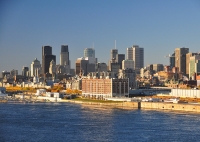
Photo credit: abdallahh
Montreal was founded as a missionary village in 1642, a century after Jacques Cartier became the first European to discover the area. Despite some undeniably English architectural and cultural influences, Montreal is today one of the world's largest French-speaking cities on an overwhelmingly English-speaking continent. A metropolis of international repute, this large inland port is framed between Mont Royal and the St Lawrence River.
It's located in the south of Canada's Quebec province, only 37 miles (60km) from the United States border, and is an important hub of North American trade. It is a spacious and captivating city, characterised by a series of underground shopping and recreation complexes linked by walkways, and the metro. It contains more than 18.5 miles (30km) of office and apartment complexes, major stores, hotels, restaurants, metro stations, parking garages, movie theatres, concert halls and more, all snugly accessible during the snowy winters.
Its population is a multicultural mix that has fostered a vibrant cultural life, showcased in a number of world-class art galleries and museums. Like most Canadian cities, Montreal has interspersed urban development with green areas, the most celebrated of which is the spacious Parc du Mont-Royal, designed by Frederic Olmsted, the American landscape artist who also designed Central Park in New York. The city boasts countless other attractions to visitors all year round, but tourists do tend to avoid the freezing winter months.
Getting around in Montreal
Montreal's sensible layout combined with an extensive and super-efficient public transport system (metro, bus and commuter rail services) make getting around the city easy. In fair weather, hundreds of kilometres of bike paths spanning the island offer a healthier, pleasant option.
Public transport is run by the Montreal Transport Society, or STM. The pristine metro has dozens of stations along four different lines with numerous stops in the city's famous subterranean mall. The metro stops are all integrated with a comprehensive network of city bus routes. Most metro services and buses run between 5.30am and 1am, with a limited night bus service filling in. The inner city services in turn connect to a commuter rail network that serves the suburbs.
Fares are standard on both the bus and metro and transfers are free; a tourist pass is available for bus and metro. Metered taxis can be hailed in the streets downtown or ordered in advance. There are numerous car rental firms in the city, but roads are often heavily congested and traffic jams are common.
Nightlife in Montreal
Ever since it earned its nickname of 'Sin City' during the country's era of prohibition, Montreal's nightlife gained a wild reputation throughout the 20th century. Even today, it's arguably home to the hottest nightlife in Canada.
One of the best areas for a night out is Saint-Laurent, with fashionable clubs and bars that are constantly being reinvented. Crescent is a popular area with those who prefer a chilled evening and is a regular choice for couples and diners.
The Latin Quarter also has a lively party scene, attracting students and tourists in substantial numbers during the summer months when the good times spill into the streets. The Gay Village is a lively cocktail of charming cafes and vibrant nightclubs, boasting some of the most raucous nightlife among both gay and straight crowds.
Bars in Montreal close around 3am. Clubs tend to open late and close around dawn. Entrance fees are usually charged but these can be avoided by calling ahead and talking your way onto the guest lists, which is not nearly as hard as it sounds.
Be aware that Montreal has some fairly advanced public health regulations that mean smoking cigarettes in bars or even near them is strictly forbidden. Do so at the risk of a fine. A drawcard for visiting young Americans is the legal drinking age of 18, as opposed to 21 across the border.
Montreal also offers loads of culture, boasting its own symphony orchestra, dozens of theatres and countless venues for live music concerts, ranging from intimate clubs to international arena tours.
Dining in Montreal
Montreal is predictably and deservedly famous for its French cuisine and is home to a number of glorious French restaurants and bistros. While Quebec's signature dish is a pile of fries, gravy and cheese curds called poutine, classics such as bagels and croissants remain ever popular in the city.
Old Montreal is naturally the main tourist district and many quality restaurants can be found along its narrow streets, but downtown also boasts a bustling culinary scene. Boulevard Saint-Laurent (La Main to locals) splits the city into eastern and western sections and is one of the best streets for eating out in Montreal.
Another good stomping ground for grazing travellers is Plateau Mont-Royal, a gourmet paradise of restaurants, bakeries and snack stalls. For a break from French-style cuisine, and good budget options, take a stroll through Montreal's Chinatown, of which Rue de la Gauchetiere is the main pedestrianised strip.
Foodies who want to explore the fresh produce scene in Montreal should visit either the celebrated Marche Jean Talon or the smaller Marche Atwater to browse the stalls; both markets are sure to delight serious gourmands.
Le Club Chasse et Peche —
French
One of the most highly rated restaurants in Montreal and a multi-award winner with the local press, Le Club Chasse et Peche is a great option for a special occasion. Known as CCP, this eatery has reinvented 'surf 'n turf' with mouth-watering Kobe beef and lobster tail.
The décor enhances the dining experience with low ceilings fostering an intimate atmosphere while the chic décor further suggests that this is a truly special dining experience. The restaurant is open for lunch, Monday to Friday from 11:30 to 2:30pm, and for dinner Tuesday to Saturday from 6pm to 10.30pm.
423 St-Claude
Montreal, Canada
http://www.leclubchasseetpeche.com
La Chronique —
French
For a taste of Montreal's rural surrounds, La Chronique is a highly regarded eatery that exclusively uses fresh local ingredients in its modern French cuisine with interesting Mediterranean and Southwestern touches. The décor is centred on dark wood and red hues framed with black and white photographs, and the wine list, exceeding 250 titles, can be ordered by the glass or bottle.
99 Laurier West
Montreal, Canada
http://www.lachronique.qc.ca
Reservoir —
International
Although a microbrewery, Réservoir is developing a name as the best value restaurant in the city, combining perfectly fresh ingredients with inventive recipes from the fertile imagination of founding Chef Samuel Pinard.
The brunch has been described by one critic as 'the most interesting (and for my money, the best) brunch experience in town'. The evenings are naturally a bit lively but this in no way detracts from the dining experience.
9 Duluth E.
Montreal, Canada
http://www.brasseriereservoir.ca
L’Express —
French
It would be remiss to list Montreal eateries without mentioning the one best known in cinema and literature: L'Express, Montreal's beloved brasserie. The eatery has handwritten menus in the style of Parisian sidewalk cafes with similar décor and serving staff attitude.
The noise reaches epic proportions when the premises is full but the food, decent prices, and all-you-can-eat pickles and baguettes makes this an essential experience for visitors to Montreal. Open weekdays 8am-2am; Saturdays 10am-2am; and Sundays 10am-1am.
3927 Rue St. Denis
Montreal, Canada
restaurantlexpress.com/en/
Jun I —
Japanese
Montreal does not have a great reputation for sushi, a sore point for maki-addicted and sashimi-fixated locals. Thank goodness then for Jun I, which flies the flag high for high-quality authentic Japanese sushi. Chef Junichi Ikematsu has developed an interesting menu based on fresh local fish, exotic rolls, and flawless nigiri, all complemented by a fine range of sake.
156 Laurier W.
Montreal, Canada
http://www.restomontreal.ca/en/1473/Jun-I-Restaurant
Shopping in Montreal
Montreal is one of those rare international cities where shopping actually enhances one's experience of the destination. Rather than kitsch souvenirs from plastic chain stores, the shopping in Montreal is as cultured and glamorous as any other aspect of the city.
Not only does Montreal have boutiques and organic markets in equal measure, but it is the world's only underground city in which to shop. For those who pay Montreal a visit during winter, this subterranean retail experience will be a welcome refuge from the icy gloom above and a highlight of their trip. The Underground City has more than 20 miles (30km) of passageways connecting all the Montreal Metros with around 1,600 little boutiques, 200 restaurants and 34 cinemas. Over 500,000 local people use the underground city every day, so we'd recommend visitors plan their shopping excursion during office hours when it is much quieter.
Montreal's two best markets are at opposite ends of the city. Marché Jean-Talon is an enormous open-air market selling high-quality goods, including fresh and organic maple syrup which one can buy by the litre, perfect as an authentic Quebec gift for sweet-toothed friends back home. Marché Atwater is another good option, with wonderful baked goods, artisanal breads and other fresh produce on offer.
The best Montreal shopping districts are Avenue Laurier Ouest, a centre of designer boutiques and foodie stores; Cours Mont-Royal for its haute couture and fashion accessories; and Ste-Catherine Street, which boasts an array of trendy stores. The iconic shopping centre Faubourg Ste-Catherine is also nearby.
For unique Montreal gifts, don't miss the Canadian Guild of Crafts Québec, which sells aboriginal art and local artisan works. This is a good place to pick up classic Canadian souvenirs such as furs and Native American crafts like dream weavers, polished stone jewellery, leather goods and musical instruments. Another must is Marché Bonsecours in Old Montreal, which has an eclectic and interesting range of shops well worth visiting.
Climate in Montreal
With predominantly wet, warm summers and cold, snowy winters, the humid continental climate of Montreal is varied and seasonal. In winter (December to February), snowfall is abundant and common both in spring and autumn. Temperatures well below freezing are experienced in winter, with average low temperatures dropping to 7°F (-14°C) in January, and the bitter weather exacerbated by wind chill.
Summer (June to August) brings sunshine and pleasant days, with high humidity on occasion, although highs seldom exceed 86°F (30°C). Rain can be expected any time of year in Montreal, but summer tends to be the wettest season. A feature of the climate of Montreal is the possibility of late autumn heatwaves, enjoyed as 'Indian summers', which frequently occur.
Sightseeing in Montreal
Despite its harsh winters, Montreal is in fact a year-round destination and travellers will be able to enjoy the bustling city's attractions and festivities no matter the season. Whether visitors enjoy outdoor sports or a trip to the opera, there are plenty of things to see and do in Montreal.
Check out Olympic Park, which hosts baseball games and concerts, or visit Old Montreal which contains beautiful historical buildings dating from the 17th to 19th centuries, as well as a few museums. The nearby old port (Vieux Port de Montréal) is a popular place for tourists as it features a huge open-air skating rink, IMAX cinema, plenty of restaurants and cafes, and a Science and Technology Center. Many tourists also take boat tours from here and a good option is to take a ferry ride across to the Parc des Iles, where the 1967 World's Fair site offers facilities for picnicking, swimming, skating or skiing in winter.
The dome of St Joseph's Oratory, visible on the flank of Mont Royal from miles away, is a famous pilgrimage site attracting more than two million visitors each year. In downtown Montreal, several blocks are connected by 18 miles (30km) of underground arcades and malls, where shoppers will be able to enjoy enclosed walking areas and great shopping opportunities, even during inclement weather. Visitors should purchase the STM Tourist Card which allows unlimited access to the bus and metro service for either one or three consecutive days.
Montreal Attractions
Olympic Park
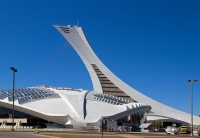
Photo credit: Tony Hisgett
Address: 4141 Pierre-De Coubertin Avenue
Website: http://www.rio.gouv.qc.ca
St Joseph’s Oratory
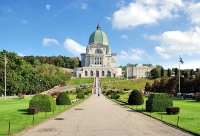
Photo credit: Taxiarchos228
Address: 3800 Queen Mary Road
Website: http://www.saint-joseph.org
Montreal Museum of Fine Arts
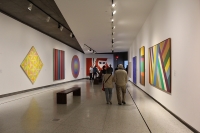
Photo credit: Shinya Suzuki
Address: 1379-1380 Sherbrooke Street West
Website: http://www.mmfa.qc.ca
Montreal Botanical Garden
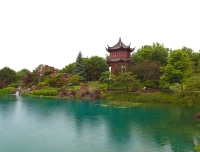
Photo credit: Patrick
Address: 4101 Sherbrooke East Street
Website: http://www.ville.montreal.qc.ca/jardin
Events in Montreal
International Jazz Festival
Thursday June 25, 2020 to Saturday July 04, 2020 (25 June to 4 July 2020)
Where: Various
Montreal's annual jazz festival (Festival International de Jazz de Montreal) is one of the best and biggest in the world. Superstars of jazz, like Oscar Peterson, Ray Charles, Dave Brubeck, and Chuck Berry have featured on the annual programme.
Today, the jazz festival features 3,000 artists and hosts more than 650 concerts (the majority of which are free outdoor events) every year. The celebrated event attracts more than two million visitors, over 30 percent of which are tourists.
http://www.montrealjazzfest.com
Montreal High Lights Festival
Thursday February 20, 2020 to Sunday March 01, 2020 (20 February - 1 March 2020)
Where: Various
Montreal's lively 11-day midwinter festival is designed to bring some light and warmth into local lives and is said to be one of the largest winter festivals in the world. It is billed as three festivals in one, having gastronomic, musical, and artistic components.
There are more than 100 concerts scheduled, more than 200 culinary and wine events, and various shows and exhibitions, many of them free of charge. Fun outdoor winter activities are also organised for the whole family. The festival attracts nearly a million spectators and foodies in particular await the event eagerly.
http://www.montrealhighlights.com
Canadian F1 Grand Prix
Friday June 08, 2018 to Sunday June 10, 2018 (TBC 2020)
Where: Gilles Villeneuve Circuit
For more than a quarter of a century, the world's top racing drivers have been meeting at the demanding Circuit Gilles Villeneuve in Montreal to battle out an important race in the Formula One World Championship.
The circuit lies on Ile Notre-Dame, a man-made island in the St Lawrence River. It includes the notorious Bienvenue au Quebec wall, which is wryly known as the 'Wall of Champions' because of all the F1 superstars who have crashed into it. Locals support the event enthusiastically and many people travel to attend it.
http://www.formula1.com
Quebec City
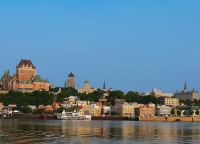
Photo credit: Rennett Stowe
The cradle of French civilisation in North America and still notably European in spirit, the historic Old Quebec neighbourhood has an unmistakable charm. Small cafes, cosy restaurants, classy boutiques, lively terraces, elegant squares, theatres, museums and street performers all come together in a fascinating weave of old-world allure.
Millions of visitors are drawn to Quebec City every year, savouring the famed Quebec gourmet scene and the beauty of the historic old district's winding cobbled streets, where 17th and 18th-century stone houses, churches, parks and a number of monuments still stand. The city is included on UNESCO's World Heritage List and is one of the only fortified cities in the Americas.
Despite having been ceded to the British in 1759, the city's population remains 95 percent French-speaking, lending a definite joie de vivre and French elegance to the atmosphere.
Getting around in Quebec City
Walking is the easiest way to explore the compact Old City of Quebec, where most sightseeing opportunities are. Many visitors also enjoy hiring a bicycle and enjoying the city's system of cycle paths.
Public buses are run by the Reseau de Transport de la Capitale (RTC), operating throughout the week (there are a limited number of night buses at weekends). Tickets are bought upon boarding with exact change or in advance from newsagents, which is cheaper. Transfers are free within 90 minutes of a single journey. One-day passes can also be bought.
Taxis can be hired at the airport, ordered by telephone, or hailed in the street in the centre of the city. Various ride-sharing apps are also an option in Quebec City.
Climate in Quebec City
Summer is undoubtedly the most popular time to visit Quebec City. June, July, August, September, and October are the only months of the year when the city is sure to be free of snow, with the annual average snowfall measuring 14 feet (4m).
It has been known to snow right up to early May. Temperatures drop well below freezing from late November to early April (Autumn/Winter), averaging between 0°F (-18°C) and 17°F (-8°C) in January.
Summer days (June to August), by contrast, are usually pleasantly warm and sunny, ideal for outdoor activities, with average highs around 77°F (25°C). Summer nights can be cool though. The city usually revels in an 'Indian Summer' for a few weeks in early October, making autumn another popular season for visiting.
Sightseeing in Quebec City
Many interesting sights and tourist attractions are located in the Old Quebec district, including dozens of small shops, boutiques and attractive historical buildings. The more modern Upper Town and Lower Town also have interesting neighbourhoods.
Quebec City is compact and easily walkable. Visitors who get tired or can't navigate the steep stairs between Upper Town and Lower Town can take a scenic ride in the Funicular, or hire one of many horse-drawn carriages for a quaint mode of sightseeing.
Attractions include the National Museum of the Arts, the Franco-American Museum and the Capital Observatory, which is in one of the tallest buildings in Quebec. Visitors could also ferry across the St. Lawrence River to Lévis and enjoy memorable views of the Chateau Frontenac and the Old City. Sunset cruises on the Saint Lawrence River are a must.
Children may relish a trip to the Chocolate Museum or a spin around the Old City's ice rink, while Villages Vacances Valcartier has waterslides and go-karting in the summer. Just a few kilometres from downtown, the unspoilt wilderness areas surrounding Quebec City present plenty of opportunities for outdoor activities and recreation, such as horseback riding, canoeing, hiking and skiing.
Quebec City Attractions
Parliament Buildings
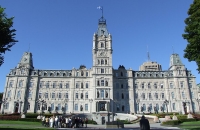
Photo credit: Christophe.Finot
Address: 1045 Parlementaires Road (visitor’s entrance: Door 3 on the corner of Grande-Allée and Honoré-Mercier Avenue)
Website: http://www.assnat.qc.ca
Place Royale
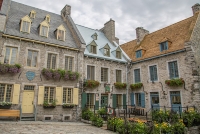
Photo credit: Tony Webster
Address: Interpretation Centre of Place-Royale, 27 Rue Notre-Dame
Website: http://www.mcq.org
Funicular
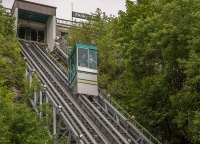
Photo credit: Tony Webster
Address: 16 Rue du Petit Champlain
Website: https://www.quebecregion.com/en/businesses/attractions/tourist-sites/funiculaire-du-vieux-quebec/
Fortifications
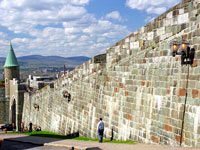
Photo credit: David Ohmer
Address: 100 Rue Saint-Louis (tours depart from the Frontenac kiosk, Dufferin Terrace)
Website: http://www.pc.gc.ca/fortifications
Old Port of Montreal
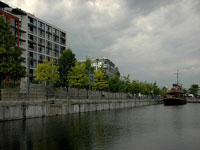
Photo credit: mricon
The Old Port is a thriving arts and entertainment venue where there's always something happening. It also offers a huge open-air skating rink, IMAX cinema, vibrant cafes and a Science and Technology Center. The clock tower offers excellent views, while the original 17th-century city fortifications still stand. Characters in period costume conduct guided tours through the streets and alleys, pointing out points of historic significance.
Address: 333 Rue de la Commune Ouest
Website: http://www.vieux.montreal.qc.ca
Battlefields Park (Plains of Abraham)
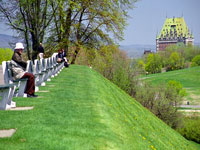
Photo credit: David Ohmer
Address: Discovery Pavilion, 835 Wilfrid-Laurier Avenue
Website: http://www.ccbn-nbc.gc.ca
Montmorency Falls Park
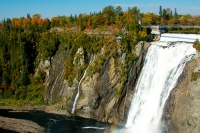
Photo credit: Dhinakaran Gajavarathan
Address: Avenue Royale, Beauport
Website: http://www.sepaq.com/chutemontmorency
L'Île d'Orléans
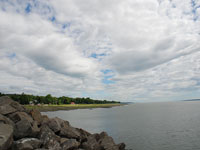
Photo credit: Alberto Otero Garcia
Address: 9 miles (15 km) from Quebec City
Website: http://tourisme.iledorleans.com/en/
Lower Town (Basse-Ville)
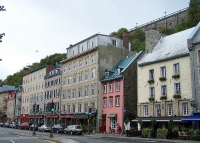
Photo credit: Kenn Chaplin
Address: On the banks of the St Lawrence River
Airports in Quebec City
Quebec City Airport (YQB)
Quebec City Jean Lesage International Airport
http://www.aeroportdequebec.com
Location: Quebec City The airport is located seven miles (11km) southwest of Quebec City.
Time: GMT -5 (GMT -4 from the second Sunday in March to the first Sunday in November).
Getting to the city: The Reseau du Transport de la Capitale (RTC) offers bus service along Route 80 from the airport to Les Saules bus terminal, operating Monday to Friday. Uber is also available.
Car rental: Car rental companies are located on the main floor of the administrative building, and include Avis, Budget, Enterprise, Hertz, and National.
Airport Taxis: Taxis are available at the information desk inside the terminal, or by prior booking. Uber is also available.
Facilities: Airport facilities include souvenir and duty-free shops, bars and restaurants, coat check and storage lockers, a VIP lounge, an information booth, a children's play area, a nursing room, currency exchange and ATMs.
Parking: The parking area is located directly in front of the terminal. A number of parking spaces near the entrance are reserved for people with reduced mobility.
Quebec Attractions
Overview
Exploring the historic fortifications and cobbled streets of Quebec City and the Vieux Port de Montreal will be a delight for history buffs. Keen travellers will be entranced by the rich, European feel of the province of Quebec and its distinctly French flavour.
Top urban attractions in Quebec's prime cities of Montreal and Quebec City include the Basilique Notre-Dame, a favourite landmark of Old Montreal; Quebec City's La Citadelle, the star-shaped fort looming above the St Lawrence River; Montreal's controversial Parc Olympique, which looks like a spaceship; and the Montreal Museum of Fine Arts.
Quebec also lures travellers with a lovely variety of wilderness areas. There are four Canadian national parks in Quebec: Forillon National Park, La Mauricie National Park, Mingan Archipelago National Park Reserve and Saguenay-St Lawrence Marine Park.
There are even more protected areas outside of these conservation hubs. Known simply as provincial parks, they include such drawcards as the Laurentian Mountains in southern Quebec, which are a particularly popular playground for those in search of natural beauty and outdoor recreation.
Olympic Park

Photo credit: Tony Hisgett
Address: 4141 Pierre-De Coubertin Avenue
Website: http://www.rio.gouv.qc.ca
St Joseph’s Oratory

Photo credit: Taxiarchos228
Address: 3800 Queen Mary Road
Website: http://www.saint-joseph.org
Montreal Museum of Fine Arts

Photo credit: Shinya Suzuki
Address: 1379-1380 Sherbrooke Street West
Website: http://www.mmfa.qc.ca
Parliament Buildings

Photo credit: Christophe.Finot
Address: 1045 Parlementaires Road (visitor’s entrance: Door 3 on the corner of Grande-Allée and Honoré-Mercier Avenue)
Website: http://www.assnat.qc.ca
Place Royale

Photo credit: Tony Webster
Address: Interpretation Centre of Place-Royale, 27 Rue Notre-Dame
Website: http://www.mcq.org
Funicular

Photo credit: Tony Webster
Address: 16 Rue du Petit Champlain
Website: https://www.quebecregion.com/en/businesses/attractions/tourist-sites/funiculaire-du-vieux-quebec/
Fortifications

Photo credit: David Ohmer
Address: 100 Rue Saint-Louis (tours depart from the Frontenac kiosk, Dufferin Terrace)
Website: http://www.pc.gc.ca/fortifications
Old Port of Montreal

Photo credit: mricon
The Old Port is a thriving arts and entertainment venue where there's always something happening. It also offers a huge open-air skating rink, IMAX cinema, vibrant cafes and a Science and Technology Center. The clock tower offers excellent views, while the original 17th-century city fortifications still stand. Characters in period costume conduct guided tours through the streets and alleys, pointing out points of historic significance.
Address: 333 Rue de la Commune Ouest
Website: http://www.vieux.montreal.qc.ca
Battlefields Park (Plains of Abraham)

Photo credit: David Ohmer
Address: Discovery Pavilion, 835 Wilfrid-Laurier Avenue
Website: http://www.ccbn-nbc.gc.ca
Montmorency Falls Park

Photo credit: Dhinakaran Gajavarathan
Address: Avenue Royale, Beauport
Website: http://www.sepaq.com/chutemontmorency
L'Île d'Orléans

Photo credit: Alberto Otero Garcia
Address: 9 miles (15 km) from Quebec City
Website: http://tourisme.iledorleans.com/en/
Montreal Botanical Garden

Photo credit: Patrick
Address: 4101 Sherbrooke East Street
Website: http://www.ville.montreal.qc.ca/jardin
Lower Town (Basse-Ville)

Photo credit: Kenn Chaplin
Address: On the banks of the St Lawrence River
News about Quebec
- F1 Driver Lance Stroll’s Guide to a Weekend in His Hometown Montreal
-
Lance Stroll is F1 royalty and a born-and-bred Quebecois. This is the Aston Martin racer's guide to Montreal, from runs through Mount Royal Park to smoked meat at Lester's. Known for its French flair, splendid parks and rugged mountain backdrops, Montreal is the largest city in
- The Sinking of the Empress of Ireland
-
The Empress of Ireland had a new captain, and it was his first voyage on the Saint Lawrence River in command of the ship carrying 1,477 passengers and crew. The Empress departed Quebec City the afternoon of
- "The Points Guy" predicts 2024 will be busiest travel year ever. He's got some tips.
-
Brian Kelly, founder and CEO of The Points Guy, says Quebec, Cairo, San Diego and Costa Rica are among some of the top travel destinations for the upcoming year
- 7 Most Welcoming Towns in Quebec
-
Canada’s French-speaking (or “Francophone”) province of Quebec is a wonderful travel destination for Americans. While its largest cities, Montreal and Quebec City, are an easy and scenic drive across the US-Canada border from places like New York City and Boston, you only have to travel a little beyond these metropolises to find yourself
- The Sinking of the Empress of Ireland
-
The Empress of Ireland had a new captain, and it was his first voyage on the Saint Lawrence River in command of the ship carrying 1,477 passengers and crew. The Empress departed Quebec City the afternoon
- Cruise Season Begins at Port of Quebec
-
On the occasion, President and CEO of Port of Québec Mario Girard awarded Captain Jorgen Cardestig with a medal honoring the first cruise ship of the year to dock at the port. This year’s cruise season at the port extends from April 25 to November 5
- 10 Reasons To Visit Quebec City Instead Of Montreal This Winter
-
Many travelers from the East Coast of the United States and from Ontario, Canada, love the convenience of a French Canadian holiday in Montreal. However, Montreal isn’t necessarily the best or only option for exploring Quebec this winter. A couple of hours outside of Montreal by
- The royal roots of Quebec's French
-
It was a perfect sun-splashed summer afternoon as my mother and I meandered through Quebec City's old town, stopping at Place Royale, a 400-year-old cobblestone square of historical greystone buildings with dormer windows and pitched roofs in red, copper and slate. My mother was born
- Why The Chateau Frontenac Is Quebec's Most Romantic Hotel
-
Quebec City is often called the heart of French Canada, and some say the historic and luxurious Fairmont Le Château Frontenac is the heart of Quebec City. Located in Old Quebec's Upper Town, Château Frontenac is the epitome of modern-day romantic elegance in an old-world setting. That it
- 2-Week Bucket List Road Trip Across Canada, Vancouver To Quebec
-
Going coast-to-coast across North America is a goal of many travelers and road-trip fanatics. There are more than a few ways of making it across the continent, but here’s one way that goes the entire distance through Canada. Travelers who enjoy spending hours on the road exploring
- Canada's Ice Hotel Is an Incredible Winter Wonderland — and Now You Can Explore It From Home
-
While the border between the U.S. and Canada remains closed throughout at least Feb. 21, Quebec is making sure Americans don't miss out on one of the coolest experiences on the continent
- The Sinking of the Empress of Ireland
-
The Empress of Ireland had a new captain, and it was his first voyage on the Saint Lawrence River in command of the ship carrying 1,477 passengers and crew. THe Empress departed Quebec City the afternoon of May 28 on its way for the transatlantic trip to Liverpool. At 2:00 am on May 29th, a heavy fog had settled over the water. Suddenly
- Why Montreal wants you to visit in the winter
-
Quebec's largest city hosts an array of cold-weather festivals that tempt visitors to venture outdoors.
- New Scenic Eclipse: Expedition Cruising In The Lap of Luxury
-
When the six-star Scenic Eclipse sets sail on its 13-day inaugural voyage from Reykjavik, Iceland to Quebec, Canada on August 15th, 2019, the launch promises to set a new standard for cruisers seeking a mix of luxury and adventure on the high seas. The ship has been aptly
- Air Canada traveler claims she woke up on 'freezing cold,' 'pitch black' and empty plane
-
Air Canada is reviewing a passenger's claim that she was left sleeping on a plane for hours after a flight landed, leaving her to find a way to escape a cold, dark and empty plane. Tiffani Adams was returning home to Toronto from Quebec and said she fell asleep "probably less than halfway" through the one-and-a-half hour flight, before waking up "around
- The Sinking of the Empress of Ireland
-
The Empress of Ireland had a new captain, and it was his first voyage on the Saint Lawrence River in command of the ship carrying 1,477 passengers and crew. THe Empress departed Quebec City the afternoon of May 28 on its way for the transatlantic trip to Liverpool. At 2:00
- Travel: 5 Destinations for a Wintertime Family Vacation
-
Check out carnival time in Quebec, or opt for a warm-weather spot, like the Greek islands. When it comes to making travel plans, the options can be overwhelming. Five intrepid experts in family travel add to the mix with their top picks for a memorable winter season adventure.
- Cruise Critic Readers Choose Their Top Destinations
-
Cruising is a great way to catch some killer views while discovering places like Alaska, Canada and the rivers of Europe. Can’t decide where to go? If you take advice from Cruise Critic readers, you'll visit all these places. The cruise website’s readers' top choices for 2018 are Glacier Bay, Alaska; Quebec City, Canada; and a host of European destinations, including Arles, Avignon and Villefranche,
- Instagram's Wannabe-Stars Are Driving Luxury Hotels Crazy
-
Three years ago, Lisa Linh quit her full-time job to travel the world and document it on Instagram, where she has nearly 100,000 followers; since then, she has stayed in breathtaking hotels everywhere from Mexico to Quebec to the Cook Islands. Often, she stays for free.
- The Sinking of the Empress of Ireland
-
The Empress of Ireland had a new captain, and it was his first voyage on the Saint Lawrence River in command of the ship carrying 1,477 passengers and crew. THe Empress departed Quebec City the afternoon of May 28 on its way for the transatlantic trip to Liverpool. At 2:00 am on May 29th, a heavy fog had settled over the water.
- A Beginners Guide to Canada: The ‘it’ Country of the Moment
-
With mountain vistas, world-class snow sports, captivating wildlife and cultural mix, Canada promises no shortage of bucket-list travel experiences. From British Columbia’s ruggedly handsome West Coast, to the Rocky Mountains in Alberta, all the way through the interior’s windswept prairies, to French-infused Quebec, and the historic east coast Maritimes, plus the impossibly friendly people who call these places home – it’s the “It” country of the moment.
- Quebec City Isn't Just A Smaller Montreal
-
The rest of Canada may be celebrating its 150th birthday this year, but Quebec has the rest of the country beat. It was founded in 1608
- Quebec's Gaspe Peninsula is Hard to Get to, Easy to Love
-
The Gaspe (gas-PAY) Peninsula is an extension of Quebec province roughly the size of Belgium that's bordered on the north by the St. Lawrence River and extends into the Gulf of St. Lawrence. It's got coastline, mountains, renowned salmon fishing and trees that turn brilliant colors in October
- Nova Scotia Noir: A Journey through Black history in Canada Reveals a Surprising Bond
-
It may not have the name recognition of better-known Canadian cities like Toronto, Montreal or even Quebec, but as the birthplace of retired professional wrestler Rocky "Soulman" Johnson - father to none other than wrestler-turned-actor Dwayne "The Rock" Johnson - and as the place where parts of the films "Titanic" (cue Celine Dion) and "Jumping the Broom" were filmed, it's safe to say that Nova Scotia holds its own as a noteworthy destination
- Restored mansion in Quebec countryside offers relaxing escape
-
This stately mansion had fallen into such disrepair that when owners Valérie Arseneau and Martin Bouchard first laid eyes on the property, rain was falling indoors and plaster was dropping off the walls
- The absolutely, positively insane sport of ice
-
People have been battling the frozen St. Lawrence River by boat for centuries. In the 1600s, it was a matter of survival. Now, ice canoeing is a serious port in Quebec - and finally amateurs can give it a bone-chilling go
- 36 Hours in Quebec City
-
In Quebec’s capital, hip and historic exist side by side, with cultural and culinary enticements for all manner of visitors
- Winnipeg's Alt Hotel offers affordable chic steps from the MTS Centre
-
Quebec chain moves westward with reasonably priced boutique accommodation that scrimps on neither style nor gracious staffing
- Quebec City Travel Guide - Quebec City Travel Tips and Reviews
-
Considered a bit of France sans attitude, Quebec City is a North American metropolis with an Old World, European feel
- In Quebec, Creativity Fuels Neighborhood Revivals
-
In St.-Roch and other neighborhoods outside the walls of Quebec’s Old City, creativity blooms, at galleries, restaurants and beyond
